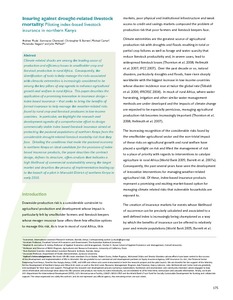Location
Vision, mission and strategy
ILRI's strategy 2013-2022 was approved in December 2012. It emerged from a wide processof consultation and engagement.
ILRI envisions... a world where all people have access to enough food and livelihood options to fulfil their potential.
ILRI’s mission is... to improve food and nutritional security and to reduce poverty in developing countries through research for efficient, safe and sustainable use of livestock—ensuring better lives through livestock.
ILRI’s three strategic objectives are:
- with partners, to develop, test, adapt and promote science-based practices that—being sustainable and scalable—achieve better lives through livestock.
- with partners,to provide compelling scientific evidence in ways that persuade decision-makers—from farms to boardrooms and parliaments—that smarter policies and bigger livestock investments can deliver significant socio-economic, health and environmental dividends to both poor nations and households.
- with partners,to increase capacity among ILRI’s key stakeholders to make better use of livestock science and investments for better lives through livestock.
This is ILRI’s second ten-year strategy. It incorporates a number of changes, many based on learning from the previous strategy (2000–2010, initially produced in 2000 and modified in 2002), an interim strategy (2011–2012) and an assessment of the external and internal environments in which the institute operates.
Members:
Resources
Displaying 566 - 570 of 1152Our land, our animals: Herding in Kenya's Kitengela rangelands
Nickson Parmisa, a resident of Kitengela just outside Nairobi in Kenya, talks about the challenges of livestock herding in the face of climate change.
Developing a vaccine for a highly contagious cattle disease
Contagious Bovine Pleuropneumonia (CBPP) is a highly contagious disease that affects cattle throughout most of sub Saharan Africa. It is one of the most serious livestock diseases with greatest impacts in pastoralist areas. Up to 15% of infected animals die: milk yields of infected cows drop by up to 90%: meat production is reduced, and infected draught oxen are less able to work. Existing vaccines have side effects and give limited protection. Research is underway at the International Livestock Research Institute (ILRI) to develop a more effective vaccine.
Herding livelihoods in transition: Kenya's Kitengela Olmakao Cultural Village
This is the story of a group of women from the Kitengela rangelands area, which boarders the Kenyan capital of Nairobi, who have come together to form the Olmakao Cultural Village to provide alternative sources of income to their livestock-based livelihoods in the face of increasingly frequent droughts that have decimated their herds.
Herding livelihoods in transition: Kenya's Kitengela Olmakao Cultural Village
This is the story of a group of women from the Kitengela rangelands area, which boarders the Kenyan capital of Nairobi, who have come together to form the Olmakao Cultural Village to provide alternative sources of income to their livestock-based livelihoods in the face of increasingly frequent droughts that have decimated their herds.
Insuring against drought-related livestock mortality: Piloting index-based livestock insurance in northern Kenya
Climate related shocks are among the leading cause of
production and efficiency losses in smallholder crop and
livestock production in rural Africa. Consequently, the
identification of tools to help manage the risks associated
with climactic extremities is increasingly considered to be
among the key pillars of any agenda to enhance agricultural
growth and welfare in rural Africa. This paper describes the
application of a promising innovation in insurance design –
index-based insurance – that seeks to bring the benefits of






